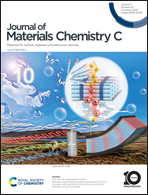Synergistic enhancement of the near-infrared luminescence properties of Ni2+-doped SrTiO3 perovskite phosphors and their application†
Abstract
Near-infrared phosphor-converted light-emitting diodes (NIR pc-LED) are a new type of solid-state NIR light source that has been used in integrated near-infrared spectroscopy and biomedical imaging. However, the NIR phosphors currently used in pc-LEDs have disadvantages such as low luminescence quantum efficiency and poor thermal stability. In this work, a new type of SrTiO3:Ni2+ perovskite-based broadband near-infrared phosphor was prepared by a high-temperature solid-state synthesis method. A combined synergistic enhancement strategy was proposed to significantly improve the NIR luminous performance of the phosphor both in terms of luminous intensity and thermostability by ion substitution with Yb3+ and co-doping with high-valence charge compensators Ta5+, which caused the distortion of octahedral unit cells. Compared to SrTiO3:Ni2+, SrTiO3:Ni2+ co-doped with Yb3+ and Ta5+ enhanced the NIR emission by about ∼23.3 fold (PLQY ∼27.46%), and improved the heat stability by 19.54%. An efficient NIR pc-LED was constructed by encapsulating the optimized phosphors with UV LED chips, and its NIR emission properties meet the requirements of high-power laser lighting. Its potential for application was further demonstrated in the bioimaging of veins of a human hand. Our work provides a new option for highly-efficient near-infrared broadband emitting phosphors and pc-LED-based NIR light sources.

- This article is part of the themed collection: 2023 Journal of Materials Chemistry C HOT Papers


 Please wait while we load your content...
Please wait while we load your content...